The heart is not understood to be an organ of feeling, but an organ of sight. The kind of seeing which arises, through imagination. Hillman proposes Corbin’s studies on himma as the foundation stone for a renewed culture of imagination, whose first principles declare ‘that the thought of the heart is the thought of images, that the heart is the seat of imagination, that imagination is the authentic voice of the heart, so that if we speak from the heart we must speak imaginatively.’
– Mat Osmond, ‘Meinrad Craighead and the Animal Face of God’ (Dark Mountain: Issue 13)
The arts for living on a damaged planet demand sympoetic thinking and action.
– Donna Haraway, Staying with the Trouble – Making Kin in the Chthulucene
‘We call it Big Shopping Trolley and Little Shopping Trolley,’ the stranger said.
‘Oh, we call it the Big and Little Dipper,’ my friend said.
‘We call it the Plough,’ I said – even though we were not actually looking at that constellation but at Orion the hunter with his sparkling belt. Three people from Poland, Canada and England.
‘It’s totally crazy,’ the Polish man continued, as our collective gaze shifted back to the golden almost-full moon between the boughs of an oak. ‘You know, the moon pulls the sea in and out! At the beginning of the night it’s here and later it will be over there! We’re moving all the time! It’s crazy.’
Joanna and I laugh. ‘It’s the Earth!’ we chorus.
Three of us standing in the dark in the middle of Wanstead Flats at moonrise. I’m finding my bearing with the stars, that are fainter here in East London than by the coast. The planes of City airport blink past red and white and the tower blocks gnash the land like giant illuminated teeth.
I’m here on this patch of common land to give a talk and a workshop at the weekend called Wild Kinship, about how it is when you meet in the wild, the untamed spaces, with a sky of stars above you, the same stars that appear above Lake Ontario and in the Polish forest, the same moon, kinship is what you feel, even when surrounded by the hostile architecture of the modern world. All of us people of the North navigating our passage through the world by the Great Bear.
Glimmer
‘We’re looking for the glimmer and the glint,’ I said, holding a small stone of quartz, before everyone in the workshop dispersed into the scrub to meet the land at the turn of the year. The shift announces itself like a creaky orchestra tuning up: a robin singing before dawn, the drum roll of the woodpecker and the sawing of titmice, a chorus of emerging green shoots and buds and wild tasselled trees. I sit down by a London Plane and breathe in the sun.
This is a practice to tune yourself into the moment: you sit alongside with the tree, the land, the river. You feel your feet on the earth, you breathe deep of the air, feel your heart beating in your chest, its rhythm. You open all your senses, notice the weather, the mood of the place and time, this quivering moment on an almost Imbolc morning. Your mind fights for your attention with its endless banal thoughts and its obsessive pointy focus. You keep breathing, focusing on your heart, and when you open your eyes, you let your attention rest on everything, let it roam among the moss and sticks and leaves, on the parakeets building a nest. The world slows to the rhythm of the heart, time expands. Then the talking talking in the head stops. You are open to the morning.
Afterward the visiting of the Flats, we went back to the community space in the ‘Inconvenience Store’ on the High Street. ‘Carry your experience back in silence’, I told everyone, ‘as if you were holding water in your hands’. People gathered in small groups to speak of their encounters in the back room.
‘I looked for the glimmer and noticed it everywhere on the blades of grass, glistening in the sun,’ Lily said in the plenary. ‘I sensed how the grass was part of me. And then I saw the spiders’ threads streaming outward in the light, as if they were somehow the threads connecting us all.’
In the ‘dreaming map’ of our encounters, what you noticed were the lines of colour that stretched across the paper; how everyone’s images and words joined up to form a continuous connecting pattern, a moving energetic stream of leaves and moss, of fox and crow, of grass, sunlight, sky, ourselves. Of spring coming.
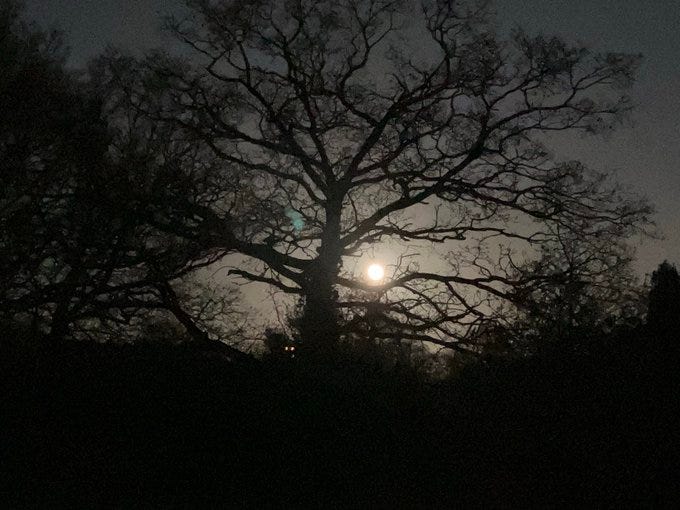

Luminescence
The light is on the ocean, pearl and silver and rose, reflecting the sky. Filigree cloud streams past the disc of the sun that is slowly emerging on this Imbolc morning, each moment lighter than before, until all the bare trees behind us are flushed with gold.
Mark and I are standing on the cliffs looking across the wrinkled oyster-coloured sea to the horizon, and it seems, in these hinge moments, that we have always been here, witnessing the sun rise, burning a fire of winter twigs in the garden the dusk before, rising in the dark, dressing by candlelight, stepping out into the widening dawn. After the sun is risen, we go to the snowdrop wood, where the white flowers carpet the floor under the yew trees by the friary ruins. We come here every year around Imbolc or soon afterwards – but this year, instead of the quiet joy the sight of these first flowers brings, there is a dislocation and dismay. The foresters have been cutting down the unloved blighted sycamores in the wood and their severed trunks lie in disordered piles, crushing the flowers.
I don’t want to see this chaos of course, but seeing with the heart demands you don’t avert your gaze, shooting off into the muttering mind and furious will, cursing the folly of human control. Staying with the trouble means staying with the kin wherever you are, not absenting. Finding some coherence, a still point within you.
So I sit for a while on a branch of a yew, hear the sea sigh against shingle, a swan’s thumping wings as it flies over. The snowdrops bow their heads to the ground before they raise them to the sky. Like all lilies they possess an intactness, a self-containment, that allows you to be still in their company. They are not quite out, the bees have yet to arrive to gather their pollen, their beguiling scent to drift in the frigid air. Nevertheless in this moment you can bow your own head to the ground on the cusp of awakening after a winter hibernation. It’s a pause in the year before the spring starts storming in.
So you pause.
I’ll come back I say, to the flowers (to my self) when you are fully open.

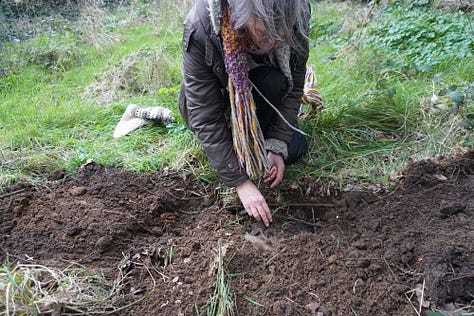
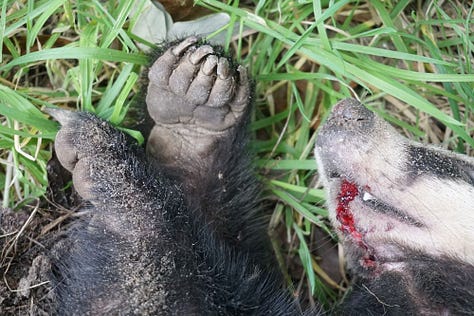
Burial
I came back with Henry. We walked along the shore in a wild south-westerly and then back to Dunwich along the heathy wooded cliff. Henry told me about the trails he has mapped along Icelandic fjords, how the beaches there sometimes have hot springs next to them, how when you are surfing the centre of a wave is the safest place to be, about a cairn of coralline slag he made on Thorpeness Beach after a massive storm surge. We sat on the sycamore stumps among the opened snowdrops and talked about which plants we best liked to forage and ferment. ‘You won’t approve,’ he said. ‘My favourite is blanched seakale stem.’
On the way back, we found a badger curled up on the road near my house and buried it in the nearby copse. A massive boar knocked by a car. Machines go too fast for the creaturely heart, and these speeding roads, here as everywhere in the modern world, are littered with wild corpses, particularly now as the seasonal slaughter of pheasants comes to its end and the birthing and mating of the mammals begin.
Finding a dead or dying creature is always an encounter you dread, and one where you most need to activate a proper response. Sometimes you stop and put them under a tree, with a flower or a prayer, sometimes you leave them for the buzzards and crows. Occasionally, if they are not too mangled, you put one in the pot. Either way, it’s a hard business. The violence of the machines roaring past you, the uncaring disregard of the people, the wild feathered or furred kin in your hand, the weight of them, the stink of death. The reversing of impotence and isolation, as you decide, with your heart, to speak out loud to the fox, or hare, or deer or owl, and lay them to rest on the land. I‘m so sorry fellow.
Henry has a performance land-based practice called ‘SeedBody’ which includes documenting burials of animals killed on the Suffolk roads. So hauling a spade out of his van, we took the brock together back into the wood.
We hunched down before the fierce beautiful creature with its bristly-brush coat and six-padded paws. Henry dug a grave and spoke a eulogy over its body, and our hands covered it with clay and we bade the badger farewell as his stripy head disappeared into the final sett of the earth.
And it felt like a long, long time had gone by since I shared a ceremony with a fellow ‘terrestrial’, who cares about the territory as much we do.
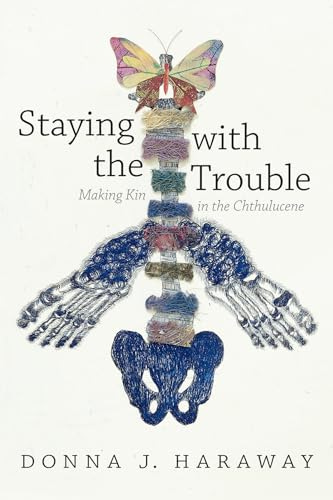
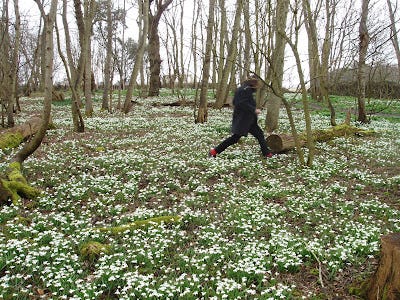
The title of Donna Haraway’s book precedes her. The expression staying with the trouble became almost a mantra in the pandemic years, but it’s only in the last month that I have fully opened its pages. It is a challenging, academic, twisty and tentacled read, but revelatory if you follow its many hyphae. You realise how many recent calls for entangled living and mycelial connection, all those metaphors about composting and fermentation, the awareness of your own microbiome, have been inspired by this philosophic study.
The Chthulucene in the subtitle refers to an epoch that follows the Anthropocene and Capitolocene periods that have caused the planetary trouble all creatures, including humans, now face. Its primary forces of partnership and regeneration demand a complete reconfiguration of the way ‘modern’ people understand life here, no longer seeing from a dominating sky god position, but from the generative underearth up. In this topsy-turvy act, we attend to our presence in places as kin with the mess of teeming life, a symbiotic ‘critter’ like all others on this Earth.
Using the structure of string figures (cat’s cradle), Haraway reweaves our intellectual attention, so it descends from its cruel and lofty ‘zone of interest’ down to the multi-celled Earth, to settle among the assemblages of squid, horses, spiders, pigeons, Monarch butterflies, Dine myths, acacia trees, lichens and bacteria. She never lets up on ‘ongoingness’, the possibilities of living and dying well, even in the most devastated territories.
To see with the heart is, to use Haraway’s term, sympoetic, Because it is a becoming-with, a seeing in relationship with, the territory where we find ourselves, whether a city park or sea cliff, or on the side of a highway. Where the book connects with this heart-seeing practice is in what the act of staying with the trouble, with these broken bones and infected trees, allows in. The holding power of the heart does not just let us perceive the complex interactions of the living world (which one-track emotions and judgemental thoughts are unable to do), but creates enough time and space to see unimagined possibilities and unexpected collaborations with our human and more-than-human kin. In these heart-governed moments our imaginations can step inside the generative imagination of the Earth.
There is a character in the final ‘Camille’ speculative stories set at the end of Staying with the Trouble known as a Speaker for the Dead. It is a role taken on by people in times of ruin and regeneration that looks hundreds of years into the future. These Speakers teach remembering and mourning practices for disappeared species to replenish the hearts and minds of those who stay with the trouble, and also to encourage an awareness of ‘the emerging kinds of beings and ways of life of an always evolving home world’.
None of us wants to address the dead that lie unacknowledged beneath our feet, in whatever country we live in. It appears a Sisyphean task. We want to see the gleam of the snowdrop in an unmolested wood. We want for the badger to return to his mate with the new litter. We want to get to the shop on time, to ignore the stream of traffic that goes to the nuclear power station. We want the story to end well. But this is not a story that can end in the way the heart might desire. Nevertheless, fearless workhorse as it is, it gets to work, knowing there are refugia where life can still flourish, that a difficult thing can bond two strangers in a moment, that everything under the stars is ongoing, and that it is the quality of ongoingness that matters.
You remember, as you touch the soil, the mythic and physical underearth, whence all new life comes. Spring only happens because of winter. It feels there can be no way to proceed in this ‘thick present’ until we begin to honour who and what we have destroyed without a second thought.
Until we notice the sun’s glimmer and the fragile threads that make us kin.
Until we remember that everything on this planet, like the heart, moves in time.
COMING UP
For those who would like to develop a heart-seeing, sympoetic land-practice with their local territories, wherever they are, there are still places for our Dark Mountain Spring Sessions that will take place next month. These sessions follow the popular winter series we held in December and are shaped around the tools and practices in our Eight Fires issue. We will be dipping our imaginative toes in the neighbourhood springs and rivers, alongside shores and draws, and crossing the spring equinox bridge together. Do get in touch if you would like to join us here.







Thanks for the reference to the book "Staying with the Trouble". I intend to put it on my "To read" list immediately. I really like the idea of seeing with the heart and not jumping into protests and objections but simply being with what is happening, witnessing the changes, and appreciating the way things happen.
Thanks Akashadevi. By all means. More flowers the better in this world!